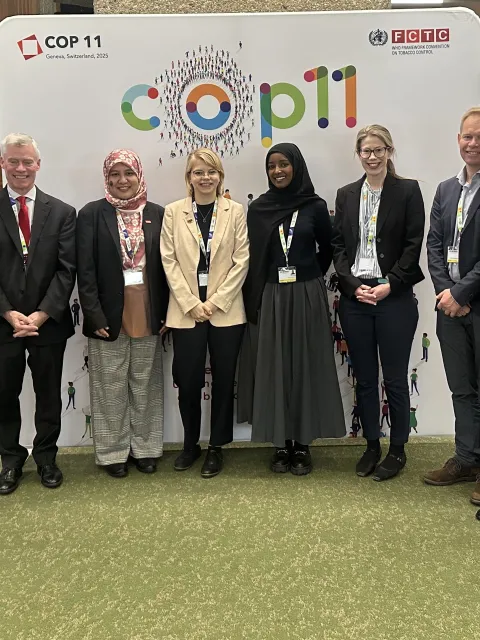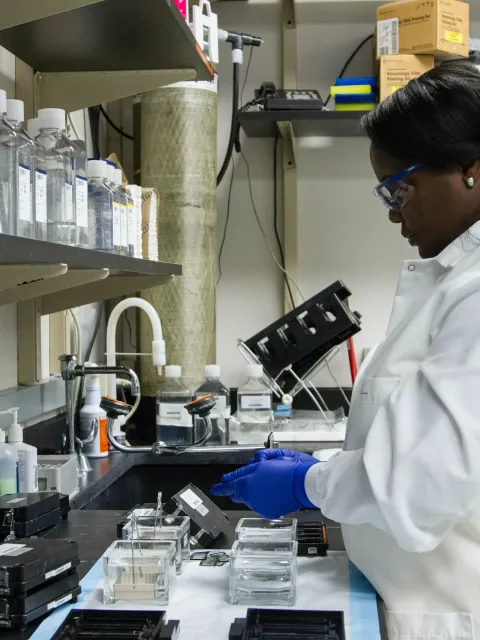For a healthier future: empowering youth against big tobacco’s tactics
In support of World No Tobacco Day on 31 May, a UICC interview with Dr Adriana Blanco Marquizo and Dr Ruediger Krech of WHO highlights the urgent need to shield youth from deceptive tobacco industry tactics exploiting new products and calls for stringent policies to curb tobacco use.

HIGHLIGHTS
-
Dr Ruediger Krech and Dr Adriana Blanco Marquizo warn that the tobacco industry targets youth with addictive new products such as e-cigarettes, falsely marketed as safer alternatives.
-
Both experts stress the importance of engaging youth activists to expose the tobacco industry's deceptive tactics and spread anti-tobacco messages.
-
Dr Krech and Dr Blanco Marquizo advocate for implementing FCTC Article 5.3, which is about protecting tobacco control efforts from commercial and other vested interests of the tobacco industry, to prevent tobacco companies from interfering in policy-making and marketing activities.
-
They also call for further comprehensive anti-tobacco regulations, including extending smoke-free laws to e-cigarettes and banning youth-appealing flavours, to protect young people from tobacco products.
In an interview with UICC ahead of World No Tobacco Day, Dr Ruediger Krech, Director of Health Promotion at the World Health Organization (WHO), and Dr Adriana Blanco Marquizo, Head of the WHO Framework Convention on Tobacco Control (WHO FCTC) Secretariat, warn that the tobacco industry is targeting and hooking youth to nicotine with new products, such as e-cigarettes and heated tobacco products, under the false claim of harm reduction.
Dr Krech pointed out some of the gaps and challenges that remain in tobacco control, such as the high smoking rates among women in Europe, the low implementation of cessation programmes and fiscal measures, the lack of data and monitoring in some countries, and the persistent and aggressive interference of the tobacco industry in undermining tobacco control efforts.
"These new tobacco products are very harmful and addictive, and there is no evidence that they help smokers quit. They are a new threat to the progress we have made in tobacco control in the last two decades."
– Dr Ruediger Krech, Director of Health Promotion, WHO
According to WHO, tobacco use is one of the leading preventable causes of death and disease in the world, killing more than eight million people every year. Tobacco is responsible for about 25% of all cancer deaths and about 20% of all cancer cases. Tobacco also increases the risk of other non-communicable diseases, such as cardiovascular diseases, chronic respiratory diseases, and diabetes.
Despite tobacco industry interference and population growth, tobacco use prevalence and the number of smokers have declined globally in recent years, thanks to the implementation of effective tobacco control policies and measures, such as taxation, advertising, promotion and sponsorship bans, smoke-free environments, graphic health warnings and cessation services.
Both Dr Krech and Dr Blanco Marquizo agree that this positive trend should encourage governments to oppose efforts by the tobacco industry to resist the implementation of these tobacco control measures and their aggressive marketing of new products that threaten to undermine this progress in public health.
The WHO FCTC came into force in 2005 and has been the main global instrument to guide and support countries in implementing the wide-ranging demand and supply reduction measures contained within the Convention. The WHO FCTC has 183 parties, representing about 90% of the world's population, and provides technical assistance, guidance and support to countries in implementing the treaty.
The WHO MPOWER package are a set of demand-reduction measures introduced by WHO that are intended to assist in the country-level implementation of effective interventions to reduce the demand for tobacco, as contained in the WHO FCTC.
“Full implementation of the WHO FCTC, which includes the six MPOWER measures, including a 100% price increase in tobacco products, could reduce smoking prevalence by almost half. We have seen many countries around the world implement the treaty, some articles more so than others, notably those about creating smoke-free environments and the packaging and labelling of tobacco products, articles 8 and 11. But I think they should have advanced more.”
– Dr Adriana Blanco Marquizo, Head of the Secretariat of the WHO FCTC
Currently, over 5.6 billion people, or more than 70% of the world’s population, are now covered by at least one tobacco control measure. Notably, 103 countries have adopted health warning laws and regulations at the highest level of achievement; 48 countries have at least three MPOWER policies in place at best-practice level, covering 1.5 billion people; four countries – Mauritius, Netherlands, Brazil and Turkey – have now achieved all six MPOWER measures at the highest level; and an additional eight countries need one more measure before achieving the full MPOWER package at best-practice level. However, 2.8 billion people globally still lack protection from comprehensive smoke-free laws, with many countries allowing designated smoking rooms.
Dr Blanco Marquizo says that the WHO FCTC is a living instrument that can be updated and complemented with new guidelines and decisions, according to the emerging challenges and opportunities in tobacco control. Some of the recent innovations that the WHO FCTC has introduced include new guidelines on tobacco portrayal in digital media and the links between tobacco, the environment and human rights.
She also emphasises the possibility of going beyond the WHO FCTC measures for countries that already have strong tobacco control policies, for instance implementing the ‘generational endgame’.
Dr Blanco Marquizo said that this strategy is not a one-size-fits-all solution and not a starting point in tobacco control, but it can work well in countries that have low prevalence, strong enforcement and comprehensive implementation of the WHO FCTC measures. “It’s important that these measures are complemented by comprehensive tobacco control strategies to create a supportive environment for these bans to be effective,” she says.
The tobacco generational endgame aims to drastically reduce tobacco use, ultimately leading to a tobacco-free society. Central to the policy is banning the individuals born after a certain year from purchasing tobacco products, effectively phasing out tobacco use among future generations.
These other measures include reducing the nicotine content in cigarettes to non-addictive levels, decreasing the number of retail outlets selling tobacco products and supporting their transition into other businesses, and enhancing smoking cessation services to assist individuals in quitting.
World No Tobacco Day 2024: Protecting children from tobacco industry interference
The theme of World No Tobacco Day 2024 is protecting youth from tobacco industry interference. This theme reflects the urgent need to raise awareness and mobilise action to prevent the tobacco industry from targeting and exploiting young people with their deceptive and harmful products and tactics.
Dr Krech and Dr Blanco Marquizo agreed that the best way to reach out to young people is to expose the tobacco industry's manipulation and to link tobacco control to the environment and sustainable development , which are more relevant and appealing to youth.
“We need to expose the tobacco industry's tactics that mislead young consumers by marketing new products as "reduced risk" alternatives”, says Dr Krech. He advocates for using influencers and youth activists to disseminate anti-tobacco messages on platforms popular among young adults.
Similarly, Dr. Blanco Marquizo calls for media campaigns that demonstrate the real-life impacts of tobacco use, and highlight the industry's deceptive practices and the true dangers of products such e-cigarettes, which are often falsely portrayed as safe.
Both agree on the necessity of comprehensive regulations to protect youth from new tobacco and nicotine products. This includes extending smoke-free laws to encompass e-cigarettes and other novel products to prevent the renormalisation of smoking behaviours, and banning flavours designed to appeal to young users.
Dr Krech and Dr Blanco Marquizo are also vocal about the need to counteract the tobacco industry's interference in policy-making. Dr Krech calls for a rejection of any partnerships or agreements with the industry, which often use such relationships to undermine tobacco control measures. "We must expose and counter the industry's attempts to portray themselves as part of the solution, while they continue to engage in tactics that are clearly part of the problem," he states.
Dr Blanco Marquizo urges the implementation of WHO FCTC Article 5.3 to prohibit any interactions with the tobacco industry that could appear as partnerships or socially responsible activities. "It is critical to ensure full transparency on the industry’s lobbying and marketing activities to prevent them from interfering in policy-making processes," she adds.
They also stressed the importance of engaging and empowering youth as agents of change and leaders of tobacco control in their communities and countries, as Wthe involvement of youth activists and civil society is crucial in this fight,” says Dr Krech, who praised their efforts at the recent Conference of Parties in Panama City, where youth groups actively raised their voices and made substantial contributions to the proceedings. A total of 22 intergovernmental and nongovernmental organisations, including UICC, were present at the COP in Panama.
"We need to work together with governments, civil society, media, health professionals and educators to support the World No Tobacco Day campaign, and to implement the WHO FCTC as the most effective way to protect the health and well-being of current and future generations from the devastating consequences of tobacco use
– Dr Adriana Blanco Marquizo, Head of the Secretariat of the WHO FCTC
Last update
Monday 27 May 2024
